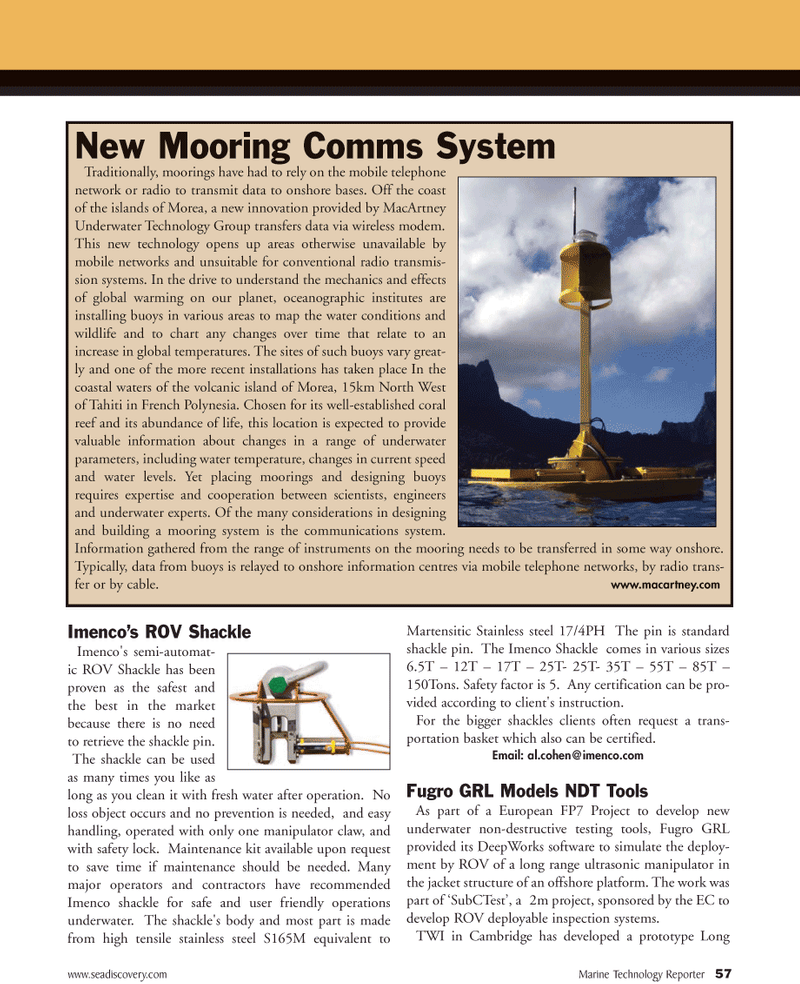
Page 57: of Marine Technology Magazine (March 2011)
Subsea Vehicles: AUV, ROV, UUV Annual
Read this page in Pdf, Flash or Html5 edition of March 2011 Marine Technology Magazine
Imenco’s ROV Shackle
Imenco's semi-automat- ic ROV Shackle has been proven as the safest and the best in the market because there is no need to retrieve the shackle pin.
The shackle can be used as many times you like as long as you clean it with fresh water after operation. No loss object occurs and no prevention is needed, and easy handling, operated with only one manipulator claw, and with safety lock. Maintenance kit available upon request to save time if maintenance should be needed. Many major operators and contractors have recommended
Imenco shackle for safe and user friendly operations underwater. The shackle's body and most part is made from high tensile stainless steel S165M equivalent to
Martensitic Stainless steel 17/4PH The pin is standard shackle pin. The Imenco Shackle comes in various sizes 6.5T – 12T – 17T – 25T- 25T- 35T – 55T – 85T – 150Tons. Safety factor is 5. Any certification can be pro- vided according to client's instruction.
For the bigger shackles clients often request a trans- portation basket which also can be certified.
Email: al.cohen@ imenco.com
Fugro GRL Models NDT Tools
As part of a European FP7 Project to develop new underwater non-destructive testing tools, Fugro GRL provided its DeepWorks software to simulate the deploy- ment by ROV of a long range ultrasonic manipulator in the jacket structure of an offshore platform. The work was part of ‘SubCTest’, a 2m project, sponsored by the EC to develop ROV deployable inspection systems.
TWI in Cambridge has developed a prototype Long
New Mooring Comms System
Traditionally, moorings have had to rely on the mobile telephone network or radio to transmit data to onshore bases. Off the coast of the islands of Morea, a new innovation provided by MacArtney
Underwater Technology Group transfers data via wireless modem.
This new technology opens up areas otherwise unavailable by mobile networks and unsuitable for conventional radio transmis- sion systems. In the drive to understand the mechanics and effects of global warming on our planet, oceanographic institutes are installing buoys in various areas to map the water conditions and wildlife and to chart any changes over time that relate to an increase in global temperatures. The sites of such buoys vary great- ly and one of the more recent installations has taken place In the coastal waters of the volcanic island of Morea, 15km North West of Tahiti in French Polynesia. Chosen for its well-established coral reef and its abundance of life, this location is expected to provide valuable information about changes in a range of underwater parameters, including water temperature, changes in current speed and water levels. Yet placing moorings and designing buoys requires expertise and cooperation between scientists, engineers and underwater experts. Of the many considerations in designing and building a mooring system is the communications system.
Information gathered from the range of instruments on the mooring needs to be transferred in some way onshore.
Typically, data from buoys is relayed to onshore information centres via mobile telephone networks, by radio trans- fer or by cable. www.macartney.com www.seadiscovery.com Marine Technology Reporter 57

 56
56

 58
58
